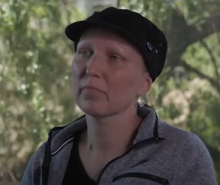Case Presentation

Melissa is a very pleasant 39-year-old woman who has been suffering from headache nearly every day for the last 4 months. She is having an average of 30 days of headache per month, with 15 days of severe headache per month. Each headache can last anywhere from 5 to 24 hours per day. The pain is located at the bilateral occipital area and is pulsating and throbbing. The average pain intensity is 5/10, up to 9/10 with severe headache. She reports that severe headaches are associated with nausea/vomiting, light sensitivity, lightheadedness, difficulty concentrating, and anxiety.
The headaches interfere significantly with her job and activities of daily living. She has a master’s degree and works full time as a Senior Finance Manager and is now missing about 3 days of work a month. She has seen multiple providers for this problem. Today Melissa returns to the clinic to discuss her ongoing headaches.
Melissa Describes Her Headache Experience
Making a Diagnosis Using the International Classification of Headache Disorders (ICHD-3)
Recognizing specific headache diagnoses is the key to effective treatment. Chronic headaches tend to be much more disabling than episodic headaches. Often medication overuse headache, which is a leading modifiable cause of chronic headache, goes unrecognized.1 Medication overuse headache (MOH) is the 20th leading cause of Years Lived in Disability (YLD), with significant economic and emotional burden for our population, making it an essential diagnosis to identify and treat promptly.2 The International Classification of Headache Disorders 3rd edition (ICHD-3) is the gold standard for accurate clinical diagnosis of any headache disorder.3
Chronic Migraine
Chronic migraine is defined by ICHD-3 diagnostic criteria as the presence of headache on more than 15 days per month, with at least 8 of those days per month meeting criteria for migraine or defined or treated by the patient as migraine. Chronic migraine symptoms commonly present with a combination of tension type headache and migraine type headache and many patients also experience chronic neck pain, but should be given diagnosis of only one specific headache type, chronic migraine. All headache types are included in the total days of headache per month. Episodic headaches (less than 15 days a month) transform into chronic headaches (15 or more days a month) at a rate of 2.5% per year.4
The ICHD-3 Chronic Migraine diagnostic criteria3
- Headache (of any type) occurring > 15 days per month for > 3 months and fulfilling criteria 2 and 3.
- Occurs in a patient who has had at least five attacks and fulfills the criteria of A or B below.
- On > 8 of those days per month for > 3 months fulfilling either the criteria for A, B or C.
- Migraine without aura:
- Headache attacks lasting 4-72 hours (untreated or unsuccessfully treated).
- During headache, at least one of the following:
- nausea and/or vomiting
- photophobia and phonophobia
- During headache, at least one of the following:
- Headache has at least two of the following four characteristics:
- unilateral location
- pulsating quality
- moderate or severe pain intensity
- aggravation by or causing avoidance of routine physical activity (e.g. walking or climbing stairs)
- Headache attacks lasting 4-72 hours (untreated or unsuccessfully treated).
- Migraine with aura (plus part A above)
- One or more of the following fully reversible aura symptoms:
- visual
- sensory
- speech and/or language
- motor
- brainstem
- retinal
- At least two of the following four characteristics:
- at least one aura symptom spreads gradually over 5 minutes, and/or two or more symptoms occur in succession
- each individual aura symptom lasts 5-60 minutes
- at least one aura symptom is unilateral, and the aura is accompanied, or followed within 60 minutes, by headache1
- One or more of the following fully reversible aura symptoms:
Learn more at https://www.ichd-3.org/1-migraine/1-3-chronic-migraine/
Medication Overuse Headache (MOH)
The ICHD-3 defines MOH as a new type of headache or a marked worsening of a patient’s pre-existing primary headache disorder in someone who “overuses” symptomatic medication.3 Often the “overuse” can be missed, as the use is actually within prescribed limits. The incidence of MOH in the primary care setting has ranged from 21% in the primary care setting to even higher prevalence in patients presenting to specialty clinics, up to 70%.5,6
ICHD-3 Medication Overuse Headache diagnostic criteria:3
- Headache occurring on ≥15 days per month in a patient with a pre-existing headache disorder.
- Regular overuse for >3 months of one or more drugs that can be taken for acute and/or symptomatic treatment of headache.
The ICHD-3 defines medication overuse as:
- Intake of simple analgesics* and combination or acute medications must be > 15 days per month.
- Intake of triptans, ergotamines, opioids and combination analgesics must be > 10 days per month.
*The term simple analgesics or non-opioid pain medications generally refers to non-steroid anti-inflammatory (NSAID) medications and acetaminophen.
MOH headaches can improve in simple cases when the overused medication is discontinued, but this is not required to make the MOH diagnosis under ICHD-3. These criteria state that MOH as developing with as little as three months of medication overuse.3 However, clinical experts and case reports suggest that MOH can take months to years to develop.5,6,7 In more complex medication overuse headache, it is not enough to simply discontinue the offending medications. Treatment needs to address underlying causes for worsening headache such as elevated stress response, anxiety, depression, and other comorbid factors.7
To understand the mechanism of medication overuse headache, we must first discuss what we know now about migraine headache. Current updates in headache science describe headache as occurring in a cortical phenomenon, involving release of messenger molecules to start the process of headache or migraine. The disease of migraine was previously considered to be a vascular phenomenon, however we now know there are even more sophisticated sensitization pain pathways at work, with the origination of the attacks being found primarily in the central nervous system. Calcitonin gene-related peptide (CGRP) is a neuropeptide messenger molecule with a unique role in headache. CGRP has been found to be released with stimulation of the superior sagittal sinus and trigeminal ganglion and elevated CGRP levels are found during spontaneous migraine. Chronic migraine patients have elevated CGRP levels not only during migraine but also in between headache episodes. Infusions of CGRP will actually trigger a headache in migraine patients.8
In an animal model for medication overuse headache, rats who were primed with sumatriptan and then placed under environmental stress were more sensitive to touch and had increased levels of CGRP in the blood, similar to chronic migraine in humans.9 The elevated CGRP as a result of exposure to acute medication is the primary mechanism for medication overuse headache, causing the brain to be more likely to activate the headache attack in this highly sensitized state.
Clinical Pearl
Medication overuse headache should be determined by identifying the total number of days of ALL acute medications used per month.2 Individuals might be at risk for MOH if they are taking more than one acute or combination medication. This is true even if they are taking each of these separately less than 10-15 days per month.
For additional details regarding the ICHD-3 diagnostic criteria of MOH please see:
Test Your Knowledge
Which one of the following clinical scenarios is NOT considered medication overuse headache based on the ICHD-3 criteria?
Clinical Pearl
New evidence demonstrates that some of the known offending agents may have an even shorter period of time in which they can transform episodic into chronic daily headache in those that are predisposed.
- Butalbital combinations > 5 days a month.4
- Opioids > 8 days per month.7 Opioids are no longer recommended by the American Academy of Neurology for headache or fibromyalgia.10
- Triptans 3-7 days/month or less can contribute to an increased risk of central sensitization and release of CGRP.12,13
- Simple analgesics taken 10 or more days a month.11
- NSAID usage less than 5 days a month was found to be protective against the development of MOH.14
Case Study, Continued
Melissa experienced her first headache at age 10. Up until 3 months ago she had only experienced occasional headaches. She has identified many triggers that can bring on a bad headache: stress, missing sleep, skipped meals, dehydration, mental exertion and certain foods, such as cheese, chocolate and MSG. Severe headaches are sometimes preceded by, and associated with, fatigue, neck stiffness, light sensitivity and nausea. She has family history of migraine in both father and paternal grandmother. She denies insomnia, fatigue, fever, weight loss, alterations in cognitive ability, head injury, changes in vision or speech, weakness, numbness or confusion. She has no known history of malignancy or HIV.
Her Patient Health Questionnaire (PHQ-4) score is 5. This indicates mild depression and/or anxiety.15 It is important to screen for anxiety, depression and insomnia when assessing risk factors of headache. Please see https://www.oregonpainguidance.org/app/content/uploads/2016/05/PHQ-4.pdf for additional information on the questions contained in the PHQ-4 and the scoring criteria.
Melissa’s Perceived Stress Score (PSS) is 18. Which indicates she has moderate perceived stress.16 It is important to identify perceived stress because it is considered a modifiable risk factor in many mental and physical conditions, particularly headache and migraine conditions.17 Please see https://das.nh.gov/wellness/Docs/Percieved%20Stress%20Scale.pdf for detailed information on the PSS assessment and scoring criteria.
Melissa Talks About Constant Headaches
Test Your Knowledge
Emergency Headache
Which one of the following features does NOT suggest secondary headache? (There may be more than one correct answer.)
A patient presenting for the first time with headache should be assessed for life-threatening secondary causes of headache. A determination of whether clinical features of a secondary headache exist can be conducted by using a mnemonic called SNOOP.15 David Dodick, MD and his colleagues at the Mayo Clinic developed the mnemonic to help guide providers when trying to differentiate between a primary and secondary headache.18
SNOOP
S: Systemic or secondary symptoms.
Fever, nausea/vomiting, weight loss, history of cancer or HIV or other symptoms that may lead to consideration of malignancy or meningitis
N: Neurologic signs or symptoms
New confusion, impaired alertness or consciousness, loss of vision, change in speech, weakness or numbness on one side of the body would lead to consideration of stroke
O: Onset sudden
Thunderclap headache can be associated with subarachnoid hemorrhage or stroke
O: Older, onset after age 40 years
Increased risk for giant cell arteritis, cancer, stroke
P: Pattern change in headache history
Change in attack frequency, severity, or clinical features
The presentation of any of these features is clinically significant and requires a thorough physical and neurological exam, which then may lead to further evaluation with lab work, diagnostic imaging or an urgent referral to an appropriate specialist. The following section provides additional information on how to differentiate between potential primary vs secondary headache.
Test Your Knowledge
Secondary Headache
After reviewing the SNOOP criteria, which additional questions are essential to ask or confirm to determine whether Melissa is safe and not as likely suffering from a secondary headache? (There may be more than one correct answer.)
SNOOP Result
True or False? Based on the additional history Melissa’s SNOOP is positive.

